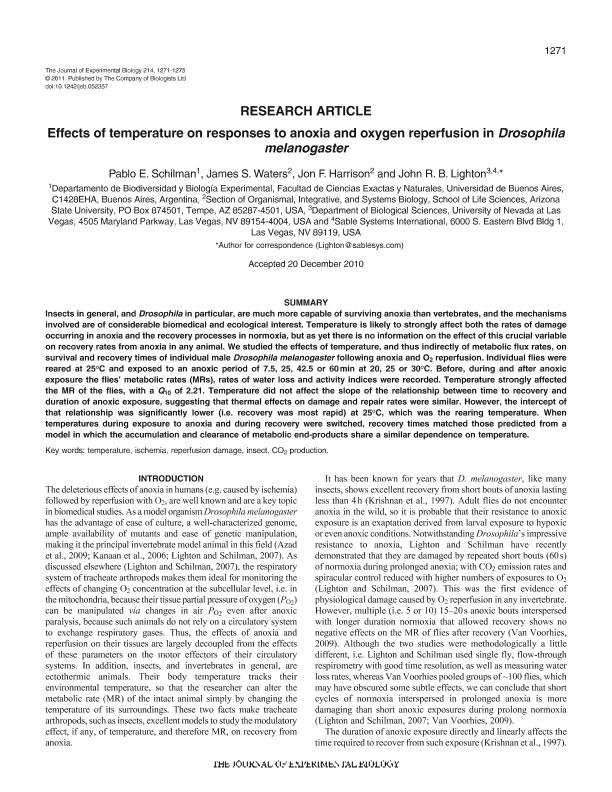Mostrar el registro sencillo del ítem
dc.contributor.author
Schilman, Pablo Ernesto

dc.contributor.author
Waters, James S.
dc.contributor.author
Harrison, Jon F.
dc.contributor.author
Lighton, John R. B.
dc.date.available
2019-01-22T16:19:30Z
dc.date.issued
2011-04
dc.identifier.citation
Schilman, Pablo Ernesto; Waters, James S.; Harrison, Jon F.; Lighton, John R. B.; Effects of temperature on responses to anoxia and oxygen reperfusion in Drosophila melanogaster; Company of Biologists; Journal of Experimental Biology; 214; 8; 4-2011; 1271-1275
dc.identifier.issn
0022-0949
dc.identifier.uri
http://hdl.handle.net/11336/68383
dc.description.abstract
Insects in general, and Drosophila in particular, are much more capable of surviving anoxia than vertebrates, and the mechanisms involved are of considerable biomedical and ecological interest. Temperature is likely to strongly affect both the rates of damage occurring in anoxia and the recovery processes in normoxia, but as yet there is no information on the effect of this crucial variable on recovery rates from anoxia in any animal. We studied the effects of temperature, and thus indirectly of metabolic flux rates, on survival and recovery times of individual male Drosophila melanogaster following anoxia and O2 reperfusion. Individual flies were reared at 25° and exposed to an anoxic period of 7.5, 25, 42.5 or 60?min at 20, 25 or 30°. Before, during and after anoxic exposure the flies' metabolic rates (MRs), rates of water loss and activity indices were recorded. Temperature strongly affected the MR of the flies, with a Q10 of 2.21. Temperature did not affect the slope of the relationship between time to recovery and duration of anoxic exposure, suggesting that thermal effects on damage and repair rates were similar. However, the intercept of that relationship was significantly lower (i.e. recovery was most rapid) at 25°, which was the rearing temperature. When temperatures during exposure to anoxia and during recovery were switched, recovery times matched those predicted from a model in which the accumulation and clearance of metabolic end-products share a similar dependence on temperature.
dc.format
application/pdf
dc.language.iso
eng
dc.publisher
Company of Biologists

dc.rights
info:eu-repo/semantics/openAccess
dc.rights.uri
https://creativecommons.org/licenses/by-nc-sa/2.5/ar/
dc.subject
Insect
dc.subject
Ischemia
dc.subject
O2 Production
dc.subject
Reperfusion Damage
dc.subject
Temperature
dc.subject.classification
Otras Ciencias Biológicas

dc.subject.classification
Ciencias Biológicas

dc.subject.classification
CIENCIAS NATURALES Y EXACTAS

dc.title
Effects of temperature on responses to anoxia and oxygen reperfusion in Drosophila melanogaster
dc.type
info:eu-repo/semantics/article
dc.type
info:ar-repo/semantics/artículo
dc.type
info:eu-repo/semantics/publishedVersion
dc.date.updated
2019-01-14T18:06:19Z
dc.journal.volume
214
dc.journal.number
8
dc.journal.pagination
1271-1275
dc.journal.pais
Reino Unido

dc.journal.ciudad
Cambridge
dc.description.fil
Fil: Schilman, Pablo Ernesto. Universidad de Buenos Aires. Facultad de Ciencias Exactas y Naturales. Departamento de Biodiversidad y Biología Experimental; Argentina. Consejo Nacional de Investigaciones Científicas y Técnicas; Argentina
dc.description.fil
Fil: Waters, James S.. Arizona State University; Estados Unidos
dc.description.fil
Fil: Harrison, Jon F.. Arizona State University; Estados Unidos
dc.description.fil
Fil: Lighton, John R. B.. University of Nevada at Las Vegas; Estados Unidos
dc.journal.title
Journal of Experimental Biology

dc.relation.alternativeid
info:eu-repo/semantics/altIdentifier/doi/http://dx.doi.org/10.1242/jeb.052357
dc.relation.alternativeid
info:eu-repo/semantics/altIdentifier/url/http://jeb.biologists.org/content/214/8/1271
Archivos asociados
